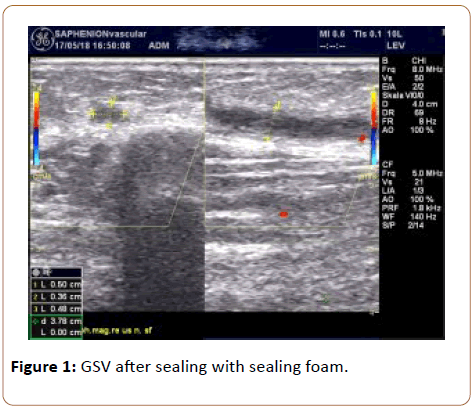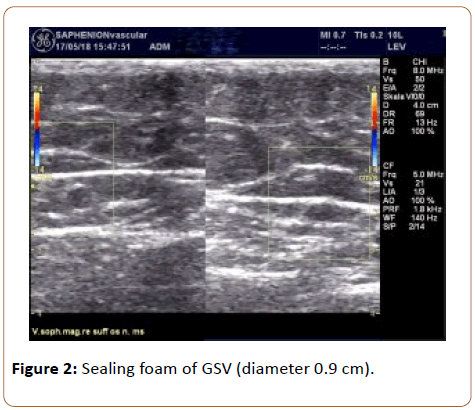Sealing Foam in Truncal Varicose Veins-Our 29 Month Experiences
Ulf Th.Zierau and Martell L
DOI10.21767/2573-4482.18.03.20
Founder and CEO of SAPHENION®-Surgeon, Vascular Surgeon, Phlebologist, Endovascular Specialist Artery, Endovenous Specialist Berlin/ Rostock, Germany
- *Corresponding Author:
- Ulf Th.Zierau
Founder and CEO of SAPHENION®-Surgeon,
Vascular Surgeon, Phlebologist
Endovascular Specialist Artery
Endovenous Specialist Berlin/Rostock, Germany
E-mail: dr.zierau@yahoo.de
Received Date: October 22, 2018; Accepted Date: November 10, 2018; Published Date: November 16, 2018
Citation: Th.Zierau U (2018) Sealing Foam in Truncal Varicose Veins-Our 29 Month Experiences. J Vasc Endovasc Therapy. 3:20.
Abstract
Sealing micro foam for varicose veins?
Sealing micro foam is a further development of the micro foam used for sclerotherapy. With the success of the vein super glue, the idea came up to further develop the micro foam. The sealing of veins has been carried out since the mid-20`s in many German hospitals. The known technical and chemical possibilities, combined with the micro-foam therapy practiced since the mid-90s, almost inevitably lead to a combination of these techniques. Glue micro foam (Sealing Foam) is one of the possible variations. We want to present our results over 29 month.
Keywords
Truncal varicose veins; Microfoam; Sonographic; Aethoxyclerol
Introduction
Micro foam is known for 80 years.
The micro foam for the treatment of varicose veins has been known since 1938. He has established himself in the 90s as a solid therapy of varicose veins and spider veins. The treatment management of the varicose disease was clearly facilitated and the therapy was gentle. In addition to finding an adhesive component, nothing new had to be sought. There were already clinical experiences from the 20s of the last century for the adhesion of varicose veins [1-3].
One very important technical development combined with the beginning of the endovenous therapy was the colour ultrasound (duplex)-we can see the catheter inside the veins, the glue and we can control the tip of catheter, the work inside the vessel and the effects inside the body-without any radiation and without i.v. contrast agents. These is a very important fact, because working with an endovenous catheter without ultrasound isn`t a fully noninvasive therapy because of using phlebography. Ratzek et al. have described exactly the sonographic appearances of common disorders of all tissues.
They have worked about the high sensitivity of ultrasound in tissue diagnostics [4-6].
Micro foam: Gold standard for treatment of reticular veins and spider veins
Since 2010, the United States Food and Drug Administration (FDA) has also approved micro foam therapy with the use of an aethoxyclerol foam to treat varicose veins and declared it the "gold standard" for spider veins and retinal vein therapy.
In Germany, the first guideline on sclerotherapy was published in 2001. It has been updated in the years 2003, 2007 and 2012 especially with regard to the micro foam therapy.
In micro foam therapy, the drug ethoxysklerol is foamed with sterile air fine bubbles and injected by means of a fine catheter into the vein. Depending on the therapist, there are ticks and tricks for refining the micro foam. Also, various additives are now added to the micro foam.
This further increases the effectiveness on the one hand. On the other hand, we want to prevent the dreaded pigmentation (ecchymosis) (Figure 1).
Results
Our results over 29 months
Since December 2006, we have successfully completed 12907 micro foam sessions.
In the last 29 months (5/2016-10/2018), Saphenion has undergone 3487 micro foam treatments. In 218 cases, trunk varicose veins were treated. These cases included a SSV in 76 cases, 81 patients with a GSV varicose, in 61 cases a VSALvaricosis. In addition, the giacomini-femoropopliteal vein on thighs and lower legs was treated in 47 cases.
The average age of patients in this therapy group was 47 years (19-82 years).
It was 0.5%-3% Ethoxisklerol used and foamed with a-since the mid-twenties also used in veins-intense adhesive sterile liquid (glucose liquid 40%-70%). The treatment duration was on average 14 minutes (5-35 min), anesthesia was not necessary in any case.
Simultaneous therapy on both legs or side branches and spider veins may be possible if the maximum amount of micro foam used in the guidelines for micro foam therapy is not exceeded.
The preoperative diameter of the varicose veins was 4.8 mm (2.7 mm-10.5 mm). The diameter of the treated veins 6 months after sealing foam was 2.6 mm (0.8-7.3 mm) (Figure 2).
Therapy success after sealing foam
Sealing micro foam therapy was 100% successful in incomplete truncal varicose veins of GSV and SSV and in types of REVAS.
All veins were closed after 29 months.
The results for sealing SSV are similarly good. This showed a closure rate of 96.1% (73 veins).
Therapy of complete GSV showed a closure rate of 88.9% (72 veins) over all the time.
Side Effects
Side effects were extremely rare. In about 5% of all cases we saw a brown discoloration (ecchymosis) over a long time (over 6 month). In two cases multiple puncture ulcers developed.
In 3 cases we found a posttherapeutic phlebitis after 3-5 weeks treatment in summer. There was not to be found deep venous thrombosis (thrombosis prophylaxis once intra operatively).
Also, the neurological complications-known from the radical stripping or thermal procedures-were not reported by our patients [7-10].
Only indurations of treated veins and hardened vein cord feeling along the treated vein were more frequently described, also muscle aching similar appearances were called.
Discussion
Sealing micro foam therapy is also very well suited for the treatment of truncal varicose veins of narrow-caliber truncal varicose veins. We are currently using Sealing Foam for truncal varicose veins if the diameter of the vein in the ultrasound examination does not exceed 5-6 mm. The effectiveness of micro foam in the case of varicosis had already been established by the European Society of Vascular Surgery (ESVS) in its 2015 guidelines [7,8,10].
Compared to radical surgical therapy and the many thermal methods used today, the side effect rate of sealing foam is lower. This is especially true for the therapy on the lower leg.
Anesthesia is not necessary.
Compression stockings are recommended by us for 7-10 days. Compared to VenaSeal, the only approved and very effective venous glue, a significant cost advantage stands out [2,7].
However, the venous glue VenaSeal allows for the treatment of all venous veins requiring treatment simultaneously in one session. This is not fully achievable with the sealing micro foam, since the amount used per session is limited [2,7,8].
In addition, the effectiveness of the micro foam in the treatment of the trunk varicose veins in comparison to the venous adhesive is very dependent on the vein diameter and the pressure conditions in the truncal varicose veins. On the other hand, however, a therapy of side branches and reticular and spider varices is simultaneously possible.
Conclusion
Sealing micro foam can also be used for truncal varicose veins of larger diameters, but in our experience a very good therapeutic effect up to a vein diameter of 5-6 mm is quite safe [11-13]. Sealing micro foam can also be used with all larger diameters, but the use of venous adhesive VenaSeal, laser or radio wave results-ignoring the possible side effects of thermal processes-has higher closure efficiency. The use of sealing micro foam will be continued consistently by us-due to the really good post-operative results [14-16].
With the further increase in experience, the indication profile will be further enhanced. Thus, in addition to the VenaSeal vein adhesive and the radio frequency therapy, we have a third minimally invasive, effective and gentle endovenous procedure available.
Conflict of Interest
The authors do not have any potential conflict of interest.
References
- https://bit.ly/2JT6ayr
- https://www.saphenion.de/news/sealing-foam-in-varicose-veins-our-29-month-experiences/
- https://www.saphenion.de/news/the-fate-of-vena-saphena-glimpses-into-the-past
- https://www.ejves.com/article/S1078-5884(15)00097-0/abstract
- Razek AA, El-Basyouni SR (2016) Ultrasound of knee osteoarthritis: Interobserver agreement and correlation with Western Ontario and McMaster Universities Osteoarthritis. Clin Rheumatol 35: 997-1001.
- Razek AA, Al Belasy F, Ahmed W, Haggag M (2015) Assessment of articular disc displacement of temporomandibular joint with ultrasound. J Ultrasound 18: 159-163.
- https://bit.ly/2DzDt9m
- https://www.phlebology.de/leitlinien-der-dgp-mainmenu/280-leitlinie-zur-diagnostik-und-therapie- der-krampfadererkrankung
- https://gesundheitsnews.imedo.de/news/1017861-krampfadern-minimalinvasive-therapien-auf-dem-vormarsch
- https://www.ejves.com/article/S1078-5884(15)00097-0/abstract
- Razek AA, Fouda NS, Elmetwaley N, Elbogdady E (2009) Sonography of the knee joint. J Ultrasound 12: 53-60.
- https://www.ejves.com/article/S1078-5884(15)00097-0/abstract
- https://www.ncbi.nlm.nih.gov/pubmed/26557230
- https://van den Bos R. et al. : Metaanalyse randomisierter klinischer Studien und Fallserien, J. Vasc. Surg., 2008, Aug.8
- https://www.ncbi.nlm.nih.gov/pubmed/28892412
- https://www.ncbi.nlm.nih.gov/pubmed/29629358
Open Access Journals
- Aquaculture & Veterinary Science
- Chemistry & Chemical Sciences
- Clinical Sciences
- Engineering
- General Science
- Genetics & Molecular Biology
- Health Care & Nursing
- Immunology & Microbiology
- Materials Science
- Mathematics & Physics
- Medical Sciences
- Neurology & Psychiatry
- Oncology & Cancer Science
- Pharmaceutical Sciences


